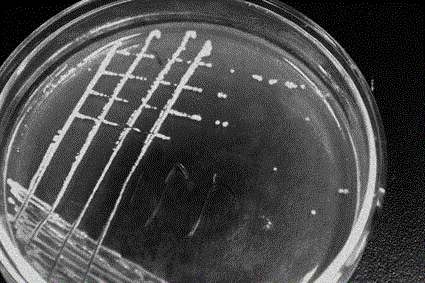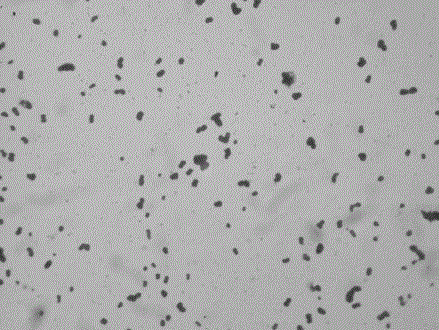Piperazine degraded paracoccus PQ-01 and application thereof
A paracoccus and bacterial agent technology, applied in the field of environmental microorganisms, can solve the problem of no piperazine, etc., and achieve the effects of low production cost, good removal effect, and reduced wastewater treatment cost.
- Summary
- Abstract
- Description
- Claims
- Application Information
AI Technical Summary
Problems solved by technology
Method used
Image
Examples
Embodiment 1
[0027] Example 1 Isolation and identification of piperazine-degrading bacteria PQ-01
[0028] Take the piperazine-enriched bacterial solution and perform gradient dilution. The diluted solution is spread on the inorganic salt solid medium containing 100mg / L piperazine, and the medium formula is: every liter contains 1.5 g K 2 HPO 4 , 0.5 g KH 2 PO 4 , 0.2 g MgSO 4 ×7H 2 O, 1.0 g NaCl, 18 g agar, pH = 7.0, culture at 30°C for several days. A single colony was picked from it, and its degradation effect was verified by HPLC, and a strain with higher degradation efficiency was stored in a -20°C refrigerator with 30% glycerol. See the picture of its colony figure 1 , identified as Paracoccus ( Paracoccus sp.); named: PQ-01. Its crystal violet staining photo is as figure 2 As shown, the main biological characteristic is G - , In the logarithmic growth phase, the bacteria are spherical or club-shaped, without spores, and without motility. It can grow with piperazine as ...
Embodiment 2
[0029] Embodiment 2 laboratory biodegradation experiment
[0030] 1. Effect of Temperature on the Degradation Efficiency of Piperazine
[0031] In nitrogen-free basal salt medium (NaCl 1.0 g L -1 , K 2 HPO 4 1.5 g·L -1 , KH 2 PO 4 0.5 g L -1 , MgSO 4 ·7H 2 O 0.2 g L -1 , pH 7.0, the same below) by adding 100mg·L -1 piperazine, with 1% inoculum into the degrading strain seed liquid (OD 600 ≈1.6), at different temperatures (15°C, 25°C, 30°C, 35°C, 40°C), shaker 160r min -1 After culturing, samples were taken after 24 hours to measure the concentration of piperazine. The result is as Figure 4 shown. It shows that the optimum degradation temperature of PQ-01 is 30℃; it still has a certain degradation ability at lower temperature, but too low or too high ambient temperature will inhibit the biodegradation of piperazine.
[0032] 2. The effect of pH on the degradation efficiency of piperazine
[0033] Add 100mg L -1 piperazine, with 1% inoculum into the degrad...
Embodiment 3
[0034] Example 3 The method for the production of bacterial agent by piperazine-degrading bacteria PQ-01
[0035]Activate the original species of the piperazine-degrading bacteria PQ-01 of the present invention on a petri dish or in an incubator, at 30°C for 30 hours, and measure the degradation performance, and inoculate it on the inclined surface of the test tube after the mature colony. The test tube seed was inoculated into a 1000ml shake flask containing 200ml LB medium, the formula of LB medium g / L: yeast extract 5.00, peptone 10.00, NaCl 10.00, pH 7.0, constant temperature shaking culture to the logarithmic phase, ready to inoculate the seed tank. The seed tank is 500 liters, the feeding volume is 400 liters, the medium formula is: glucose 0.8%, (NH 4 ) 2 SO 4 1%, K 2 HPO 4 0.2%, MgSO 4 0.05%, NaCl 0.01%, CaCO 3 0.3%, yeast extract 0.02%, pH 7.2-7.5. After the feeding is completed, 121°C high-pressure damp heat sterilization, after cooling to 33°C, inoculate ...
PUM
 Login to View More
Login to View More Abstract
Description
Claims
Application Information
 Login to View More
Login to View More - R&D
- Intellectual Property
- Life Sciences
- Materials
- Tech Scout
- Unparalleled Data Quality
- Higher Quality Content
- 60% Fewer Hallucinations
Browse by: Latest US Patents, China's latest patents, Technical Efficacy Thesaurus, Application Domain, Technology Topic, Popular Technical Reports.
© 2025 PatSnap. All rights reserved.Legal|Privacy policy|Modern Slavery Act Transparency Statement|Sitemap|About US| Contact US: help@patsnap.com



